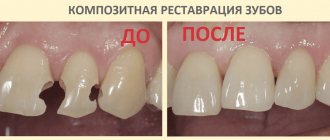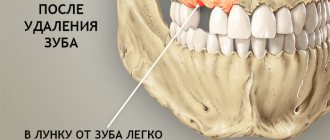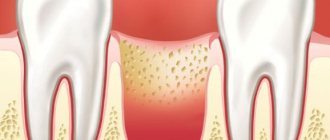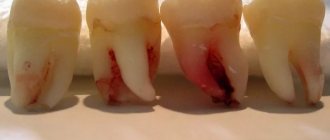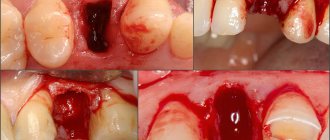Preservation of the hole - a necessity or a new trend?
Preservation of the socket - filling the cavity formed after tooth extraction with osteogenic material - is a very important component of dental treatment after tooth extraction.
This technique completely prevents bone resorption, which is known to be 25% already in the first year, which means that within 3 years the loss of bone volume can be 60%.
Preservation of the socket not only stops this process, but also preserves the gingival contour without gaps and prepares the gingival bone for future unhindered implant installation.
It is important that conservation ensures the correct load on the bone tissue, which means that at the time of implantation the condition of the bone will be exactly what is necessary for installing the implant without prior bone grafting.
Thus, preserving the socket after tooth extraction will not only save the patient from additional bone-building surgery, but will also save a considerable amount, because bone grafting is not the cheapest dental operation.
Recommendations for patients after tooth extraction surgery
Did you have to have a tooth removed? We will try to help you and remind you of the basic recommendations of doctors so that your healing process is easy and comfortable!
- Follow your doctor's recommendations carefully.
- Avoid eating for 2 hours after tooth extraction.
- During the first 24 hours, eat soft, non-irritating, warm foods.
- It is forbidden to rinse the wound during the first 24 hours after removal, to perform any manipulations to clean the hole yourself, or to apply warm compresses!
- On the first day after tooth extraction, if pain occurs, take Ketarol 1 tablet 2 times a day. If pain appears on the 3-4th day, or if your body temperature rises, consult a doctor immediately.
- Do not remove the medicine from the hole.
- You should not lift weights, play sports, go to the sauna, take a hot bath, get too cold, or drink alcohol for 4-5 days after tooth extraction.
Bleeding from the socket
After tooth extraction, the doctor usually applies a pressure bandage to the extraction site. Do not rush to take it out, even if it is unpleasant to you. This bandage should be in your mouth for 20 minutes, otherwise you risk returning to the doctor with bleeding from the hole!
And please refrain from rinsing your mouth unless your doctor prescribes it. Frequent rinsing will not stop the bleeding, but will lead to slower healing and increased pain. Usually, during the first 24 hours, the color of saliva changes due to mixing with blood. If there is severe bleeding, make a roll of sterile gauze, apply pressure to the wound with the roller and press with your mouth closed for 20 minutes. The bleeding should stop. If the bleeding does not stop, consult a doctor immediately!
Pain
After the anesthesia wears off (usually 1-2 hours after extraction), pain may appear in the area of tooth extraction. If there is severe pain, take an analgesic (Ketanov, Solpadein, Dolaren, etc.). Be sure to read the instructions for use of a particular drug, especially if there are contraindications and side effects. It is best to take the analgesic during or after meals with sufficient liquid. The choice of an analgesic, especially in the presence of concomitant pathologies (stomach ulcer, gastritis, hepatitis), is best done in consultation with your doctor or pharmacist.
Cooling
There is no need to use ice packs after simple removal. In other clinical cases, when your doctor has recommended ice, press an ice pack against your cheek on the removal side for no more than 10 minutes, with a break of 20-30 minutes. Avoid severe hypothermia of tissues. Use ice packs with caution as prolonged exposure to cold can increase pain and delay healing.
Bad habits
Smokers often have more problems after removal than those who do not smoke (for example, they are more likely to have dry sockets). The formation of a vacuum in the mouth (when you smoke or drink a cocktail through a straw) can cause the clot to dislodge. If you can abstain from smoking for two days after removal, this will undoubtedly improve the healing process.
Alcohol can dissolve the clot and irritate the wound after removal. In addition, many drugs prescribed after removal are incompatible with the use of alcohol. Therefore, refrain from drinking alcohol at least in the first days after removal.
Drugs
Be sure to inform your doctor before removal about any medications you are taking (oral contraceptives, insulin, antihypertensives, anticoagulants, etc.) so that he can choose the right anesthetic and prescribe individual postoperative care for you. The doctor may recommend you anti-inflammatory drugs (Nimesil, Mefenamic acid, etc.) after tooth extraction, especially if the extraction is difficult or there is inflammation before extraction. You should not neglect his recommendations, even if it is a course of strong antibiotics along with desensitizing drugs. If, after taking one antibiotic capsule, you feel that you do not need such strong treatment, do not stop taking the drug!!! If you suddenly stop treatment, the bacteria attacking your body may become “immune” to this group of antibiotics.
Food
If removal was difficult, your doctor may prescribe a diet of liquid or soft foods for the next 24 hours. If the removal was quite simple, you just need to make sure that you chew with teeth that are as far as possible from the extraction site. Avoid eating spicy, sour, hot and traumatic foods. After eating, oral baths are required on the first day and rinsing in subsequent days so that the hole does not become clogged with food debris. Hot liquids can dissolve a blood clot forming in the socket, so exclude them from your diet for a day after removal. Also avoid carbonated drinks and alcohol during this time, especially if you are taking antibiotics or other medications!
How to brush your teeth
During healing, it is very important to maintain good oral hygiene. On the day when the tooth was removed, it is better not to brush the teeth located in the immediate vicinity of the extraction site with a toothbrush. This does not mean that teeth do not need care at all! Moreover, good oral hygiene improves healing. Just make sure that the movements of the brush in the area near the removal are softer and more accurate. On the first day after removal, rinsing your mouth is contraindicated. Rinsing should be replaced with oral baths made from herbal decoctions or antiseptics that do not contain alcohol or other irritants.
Seams
After your tooth is removed, your doctor may stitch you up around the extraction area. Some types of thread used to make these seams subsequently dissolve by themselves; Non-absorbable sutures will have to be removed by your dentist. If you have had stitches, check with your doctor again what type of thread he used. Typically, dentists prefer non-dissolving sutures - however, the process of removing them is very simple and completely painless.
Wound healing
The wound heals after removal in 2-3 weeks. However, the healing of holes at a young age occurs somewhat faster than in the elderly. The sockets of single-rooted teeth heal faster (16-18 days) than multi-rooted ones (19-23 days). In the presence of inflammation in single-rooted teeth, delayed healing is observed for 1 week, and in multi-rooted teeth - 2 weeks later. The delay in epithelization also has a direct relationship with the traumatic nature of the tooth extraction operation. The more severe the removal, the longer the healing.
On the 3-4th day after tooth extraction, the development of granulation (soft young) tissue begins. At this time, white crusts of newly formed epithelium are observed on the surface of the socket. Tearing or scraping it off is strictly prohibited!!! By day 14, the hole is completely filled with this tissue.
Two weeks after the operation, elements of new bone tissue appear on the bottom and side walls of the socket; by the end of the first month, the socket begins to fill, and by the 45th day it is completely filled with young bone tissue.
By the end of the 3rd month, newly formed mature bone tissue fills the entire socket.
By the end of 4-6 months, and in a complicated course - by 8-10 months, it is not possible to distinguish the socket from the surrounding bone radiographically. In older people and in the presence of concomitant diseases, wound healing occurs more slowly.
If implantation is not planned, is socket preservation necessary?
If implantation is not planned, preservation of the hole will still be the right decision. This simple procedure will, at a minimum, speed up the healing process of the hole and completely prevent all sorts of risks of complications and infection, and at most - taking into account the fact that you should never say “never” - it will be very useful when you need to install an implant. In other words, this is a real opportunity to give the patient choice.
Preservation of the socket after tooth extraction is recommended for anyone who needs to install an implant in place of a missing tooth. This procedure will help preserve the volume of jaw bone and the natural contours of the alveolar process, and subsequently avoid alveolar bone augmentation for implantation.
There are practically no contraindications
except for acute pain. But even in this case, everything is individual, taking into account medical indications corresponding to the specific clinical situation.
Advantages of socket preservation after tooth extraction
- Minimum healing time for a socket after tooth extraction.
- Preventing infection from entering the socket.
- Preservation of bone tissue.
- The aesthetic appearance of the gingival contour is a guarantee of aesthetic prosthetics.
- Possibility to install an implant 1 month after tooth extraction.
- No need for augmentation.
The advantages of the procedure are obvious, which is why preservation of the socket after tooth extraction is very popular in dental dentistry.
100% guarantee of successful surgery - high-quality osteoplastic materials.
Materials for hole preservation Genoss (South Korea)
— the best bone replacement materials for socket preservation today.
After tooth extraction
After tooth extraction: how to speed up recovery
Tooth extraction can be indicated even for those who take care of hygiene, regularly brush their teeth, and are not susceptible to any dental diseases.
The reason for extraction may be improper growth of teeth - dystopic or impacted elements of the dentition must be removed. Supernumerary teeth should always be removed. As for teeth affected by caries or moving elements in patients with periodontal disease, the decision is made individually, based on the specifics of the clinical case. In this publication we talk about what to do after tooth extraction - how to properly care for the oral cavity, what medications to take, what to eat, whether you can drink alcohol, smoke and play sports.
How to eat properly?
After tooth extraction, the restriction on food intake lasts for a very short time. In fact, you will be able to eat your next meal almost immediately after returning home from the dental clinic. It is recommended to abstain from food for two, maximum, three hours. After this, it’s time to replenish the energy and nutrients that are needed for quick and complete healing of the wound.
You can drink even earlier - within an hour and a half after tooth extraction, you can drink a glass of mineral water or yogurt. We recommend giving up sweet soda, tea and coffee for a couple of days.
The next important question is what to eat? It is advisable to eat liquid or pureed food. The chewing load should be kept to a minimum, and therefore it is better to avoid beef steak, which requires careful and prolonged chewing. A good choice would be soup, mashed potatoes, oatmeal, omelet, cottage cheese, buckwheat porridge. If you want to add meat to your diet, first pass it through a meat grinder (in finished form).
Now let's talk about how to eat correctly? The recommendation is logical and expected - you need to chew food on the healthy side. Food particles should not get into the wound or damage the blood clot, which is an important element of healing.
When to remove a tampon?
After dental extraction, the dentist will apply a gauze pad to the wound. This will reduce bleeding and promote blood clot formation. The problem is that very soon this tampon will turn into an ideal source of nutrients for microorganisms living in the oral cavity. Simply put, it will become a breeding ground for infection.
If the tampon has not yet been removed at the dental clinic, do so immediately after returning home. Just remove the tampon carefully, otherwise there is a high risk of tearing out a blood clot from the hole. In order to properly remove a tampon, pull it not strictly up (or down), but to the side, with smooth loosening movements. This way you are guaranteed to avoid troubles that are possible when removing a clot from the hole.
What should I do if, after removing the tampon, blood continues to come out of the socket? Make the same tampon yourself, soak it in an antiseptic and apply it to the gum in the area of the hole for a couple of hours. For hypertensive patients, we recommend measuring your blood pressure. High blood pressure can cause bleeding from the socket, and therefore, if the systolic or diastolic pressure increases, you should take antihypertensive drugs prescribed by your cardiologist.
How to reduce swelling?
Simple tooth extraction is accompanied by minimal tissue trauma, but in the process of complex extraction, bone damage is much more noticeable to the body. The response to this damage may be swelling of the gums, cheeks and even half of the face on the side of the operation (tooth extraction - a surgical dental procedure).
To minimize swelling, apply cold compresses to your cheek. It's important not to overdo it here. Applications should be short-term - no longer than five minutes. Then you should take a break for about 10-20 minutes and apply the cold to your cheek again. Repeat the procedure 3-5 times. Please note that compresses are effective only in the first hours after dental extraction; there is no point in using them later.
An effective measure against edema is to take antihistamines, which are available without a prescription. These medications reduce the release of inflammatory mediators (the main one being histamine) and thereby prevent the development of edema. You need to take antihistamines (diazolin, suprastin) once a day for two or three days.
What you definitely should not do after tooth extraction is to heat the area of the surgical wound. Do not apply heating pads to your face or take a hot bath or hot shower. Of course, visiting the bathhouse until complete healing is also prohibited.
What should smokers do?
It is better to abstain from smoking for at least 2-3 days, but few smokers will be able to follow such recommendations after tooth extraction. For those who need to get their regular dose of nicotine, we advise you to wait at least three hours. Nicotine provokes a narrowing of peripheral blood vessels, which impairs the delivery of oxygen and nutrients and slows down the process of tissue regeneration in the socket area.
Alcohol after tooth extraction
Tooth extraction surgery becomes very stressful for most patients. A common way to calm nerves for many is a small portion of alcohol. Is such a measure acceptable after dental extraction?
If the dentist has prescribed a preventive (prophylactic) course of antibiotics, you must abstain from alcoholic beverages throughout the entire period of taking antibacterial drugs. If antibiotics were not prescribed after tooth extraction, you can drink alcohol on the second or third day. It turns out that to relieve stress, in any case, you will have to look for other methods. A good choice is tablets (not tinctures!) herbal-based sedatives, available in a large assortment in pharmacies.
What medications should I take?
Medicines are prescribed by the dentist who performed the extraction. The goal of drug therapy is to reduce pain, prevent inflammation and infection of the socket, and minimize swelling.
Pain after surgery appears 2-3 hours later, when the anesthesia wears off. As a rule, the pain is not very severe, but there is no need to endure it. To reduce discomfort, the doctor will prescribe potent medications. Ketanov in ampoules or its analogues are often prescribed. These drugs, in addition to the analgesic effect, have a strong anti-inflammatory and anti-exudative effect. They not only relieve pain, but also reduce swelling and inflammatory reaction in the socket area.
Antibiotics
Antibiotics after tooth extraction are prescribed in cases where the operation was performed against the background of inflammation, or when there are untreated teeth in the oral cavity that are a source of infection. Simply put, when the risk of wound infection is high. After a complex extraction, including after the removal of a wisdom tooth, antibiotics are almost always prescribed.
The doctor may prescribe you antibiotics in the form of tablets/capsules or solution for intramuscular injection. Antibiotics such as Cefazolin, Cifran, Amoxiclav are often used. It is very important to adhere to the dosages prescribed by the dental surgeon. It is highly undesirable to exceed or independently reduce doses.
The preventive course of antibacterial drugs is designed for 5-7 days. Usually the patient's condition returns to normal by the end of this period. If in the first days, in addition to swelling and pain, you may be concerned about an increase in body temperature up to 38-38.5 degrees, then after a week the symptoms of the postoperative period disappear.
If, a week after extraction, you continue to experience pain, fever, bleeding from the socket, or other symptoms, make an appointment with your doctor!
To reduce swelling, you can take antihistamines, which have already been mentioned. Do not use acetylsalicylic acid or other NSAID drugs that reduce blood clotting. Patients with cardiac pathology who are taking anticoagulants for health reasons should discuss this issue in detail with their doctor.
How to care for your oral cavity?
To prevent infection, the dentist will prescribe not only antibiotics, but also antiseptic solutions that need to be used to rinse the mouth. You should always rinse your mouth with antiseptics, even when the patient is not prescribed antibiotics. After the removal of a wisdom tooth, the recommendation is as relevant as after the extraction of a diseased element of the dentition.
You need to rinse your mouth very carefully, otherwise you may accidentally wash out a blood clot from the postoperative hole. In fact, we are not talking about rinsing, but about a kind of bath with an antiseptic drug (most often, dentists prescribe a solution of chlorhexidine - an effective and inexpensive antiseptic).
Place the solution in your mouth, hold it on the side of the operation, and then carefully spit it out. It is not recommended to swallow the antiseptic, although it is not toxic. You need to repeat such washings 3-4 times a day. It is advisable to do the procedure after meals.
How to brush your teeth? The answer to the question is quite simple - the only recommendation concerns careful cleaning of the teeth on the side of the operation. Continue to brush your teeth as usual, thoroughly cleaning the lingual and vestibular surfaces, but avoid sudden movements and use reasonable caution. And continue to floss with the same amount of caution.
What should you not do after tooth extraction?
Like any operation, tooth extraction imposes certain restrictions on lifestyle. They do not last long - about seven days - but you cannot break the rules, as this is fraught with the development of complications. Follow these guidelines:
- If you play sports, take a break from training for 7 days.
- Do not go to the solarium or bathhouse, do not swim in the pool.
- Don't take hot baths.
- Do not open your mouth too wide (this may result in a blood clot falling out of the socket).
- Do not take acetylsalicylic acid, direct and indirect anticoagulants and antiplatelet agents (except when they are taken for health reasons).
When are stitches removed?
The sutures are not removed, since absorbable suture material is used in dental surgery. After extraction, the doctor sutures the gum above the hole to prevent the blood clot from being washed out and to create an additional barrier against microorganisms. The tooth extraction operation takes place under non-sterile conditions, since it is not possible to completely sanitize the oral cavity (and this will do more harm than good).
In general, the question regarding seams is not as simple as it seems. After wisdom teeth are removed, as well as after complex extractions, sutures are almost always required. But after a simple extraction, some doctors for some reason do not stitch the wound. You can ask the doctor in advance to put one or two stitches. You may have to pay an additional 500 rubles, but this simple measure will help speed up wound healing and significantly reduce the likelihood of complications (alveolitis, infection, socket suppuration).
If you still have questions about the rules of recovery after tooth extraction, ask them during a personal consultation with a medical dentist (Moscow).
Genoss bone replacement materials
Genoss are bone substitutes of the highest quality, which have been successfully used in dentistry for a very long time.
When are Genoss osteoplastic materials used?
Genoss have proven themselves to be excellent in filling sockets at the site of an extracted tooth, dental implantation, bone ridge plastic surgery, filling cystic hilar cavities, in the case of post-osteotomy techniques, in restoring periodontal tissues, and filling cavities during sinus lifting.
Benefits of Genoss
- One hundred percent biocompatibility with tissues of the human body.
- High resorbability.
- Rapid tissue healing.
- Improvement of hemostasis.
- Easy to use.


